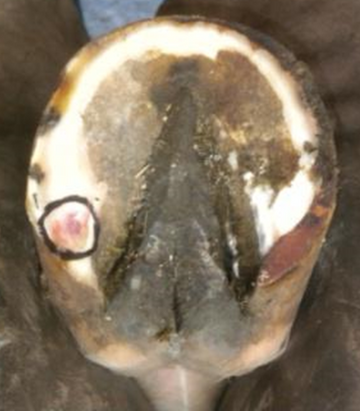Corns
Corns are defined as a bruising on the caudal solar surface of the sole at the angle between the hoof wall and the bar known as the seat of corn. 1,2,6,7 Bruising is a traumatic injury to an area that results in hemorrhaging to the sensitive tissues of the sole.2,3,6,7 Corns may develop suddenly (acutely) or occur over time (chronically).2,4

Corns do not always result in lameness. If the horse does become lame, it is typically not severe. Lameness and discoloration of the sole in the Seat of Corn are the most common symptoms that can alert you that the horse is suffering from a Corn. Depending on the severity, other symptoms may include forelimb lameness, reddish or yellowish discoloration on the sole of the foot in the Seat of Corn area, pain when pressure is applied to the area, increased strength of a digital pulse in the foot, and increased warmth of the foot.1-7
There are three types of Corns: Dry, Moist and Suppurative.1,2,4
Dry corns indicate a mild bruising and hemorrhage between the sole and sensitive tissues that causes thinning of the sole over the seat of corn. Blood accumulates creating a reddish area that can be seen when the sole is pared with a hoof knife.1,2,4,7
Moist corns (sometimes called a wet corn) are a more serious trauma that causes inflammatory fluids or serum to accumulate under the sole and can open releasing pus or serum.1,2,4,7


Corns are usually seen more commonly in the medial (inside) of the front feet. Corns can occur in bare footed horses as well as shod horses.1,2,5,6
Common causes of Corns are:1-7

The first step in the treatment for Corns is to identify the insult or cause. If the Corn is suppurating, it will need to be pared out much like an abscess in order to create drainage for the infection. 1,2,4,6,7 Depending on the severity, the horse may need to be rested until recovered.1,2 Farrier treatment options will depend on whether the horse is bare or shod, and what the insult or cause of the Corn was from.
Recovery from a Corn is good with proper care and removal of the insult or cause. Proper trimming and/or shoeing techniques are necessary to prevent future occurrences of many Corns in horses.1-7
References and Resources
1. Merk Manual, Veterinary/Musculoskeletal System/Lameness in Horses/Bruises Soles and Corns In Horses. Bruised Sole and Corns in Horses - Musculoskeletal System - Merck Veterinary Manual (merckvetmanual.com). Last full review/revision Sep 2015 | Content last modified Jun 2016.
2. Corns in Horses. Deidre M. Carson, BVSc, MRCVS & Sidney W. Ricketts, LVO, BSc, BVSc, DESM, DipECEIM, FRCPath, FRCVS. Corns in Horses | VCA Animal Hospital (vcahospitals.com).
3. Large Animal Sugery – Supplemental Notes. Malone E, Norton E, Dobbs E, and Exxo A. University of Minnesota Library Publishing. Solar Bruising and Corns, pages 857-8.
4. Corns in Horses. Corns in Horses - Symptoms, Causes, Diagnosis, Treatment, Recovery, Management, Cost (wagwalking.com).
5. Identifying and Treating Corns in Horse Hooves (useventing.com). NOV 29, 2017.
6. Corns in Horses. PetMD Editorial. November 8, 2011. Corns in Horses | PetMD.










